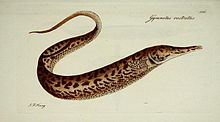Rhamphichthys
These fish are eel shaped (or anguiform) with a distinct beak like snout which gave them their name.
[1] Like most other knifefish Rhamphichthys species have electrical organs that help them live in the murky waters of South America.
[5] They have been found in pools created during the rainy season then become isolated as the waters recede.
[1][4][5] These waters are usually extremely murky and full of silt deposits which makes sight difficult, perfect for organisms that can detect their surroundings with weak electric signals.
Internally they have highly reduced gill rakers, a large stomach, and an anteriorly positioned anus which lies directly under the pectoral fins.
They are opportunistic predators feeding predominately on invertebrates such as insects and crustaceans dug up from the sandy river bottoms, but seem to eat small fish as well.
Note that the phylogeny in this image is incorrect: all recent phyoogenetic and phylogenomic studies report the following interfamily relationships: Gymnotidae ((Hypopomidae, Rhamphichthyidae) (Sternopygidae, Apteronotidae)).
Model-based total evidence phylogeny of Neotropical electric knifefishes (Teleostei, Gymnotiformes).
Rhamphichthys, like other Gymnotiformes fishes, contain an electric organ that takes up the back third if the body.


